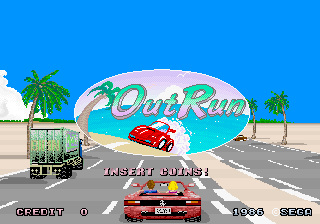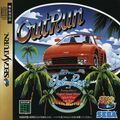OutRun
From Sega Retro
This short article is in need of work. You can help Sega Retro by adding to it.
| OutRun |
|---|
| System(s): Arcade (Sega OutRun Hardware), Amiga, Amstrad CPC, Atari ST, Commodore 64, DOS, J2ME, MSX, Sega Game Gear, Sega Master System, Sega Mega Drive, Sega Saturn, TurboGrafx-16, ZX Spectrum |
| Publisher: Sega |
| Developer: Sega AM2 |
| Genre: Driving |
OutRun (アウトラン) is a successful arcade driving game developed by Sega AM2 in 1986. It was designed by Yu Suzuki, and went on to inspire numerous sequels and re-releases. It is one of Sega's most iconic franchises as it was the first arcade game to deliver a sense of speed while making use of Super Scaler technology to create a psuedo-3D look and feel. It also contains multiple routes and multiple endings. Its music, composed by Hiroshi Miyauchi was also extremely popular as well, as each of the three in-game music tracks were much longer and more varied than what other arcade games were offering at the time. It was also one of the first games to allow you to pick a music track to race with.
The goal is to simply drive your sports car to one of the goals without running out of time. Crashing into either other cars or scenery does not cause the player to lose lives, just time. After an area is cleared checkpoints will allow the player to increase their time, and there will also be the option to select the next area through the form of a fork in the road. There are five possible endings, each with their own closing cinematic. Rather than be classed as a "racing game", Yu Suzuki classifies OutRun as a "driving game".
The player's car looks strikingly similar to a Ferrari Testarossa, so much so that the two companies would later have some court encounters over it. In later games, the car is either generic with no obvious ties to a company, or, in the most recent games, a real Ferrari. Other cars on the road appear to be a 1972 Volkswagen Beetle, a 1971 Chevrolet Corvette, a 1985 Porsche 911, a 1985 BMW 325i Cabriolet E30 and a truck. The game's scenery is largely inspired by Europe, after a European trip Suzuki travelled on for inspiration. This would be explored in more detail in the sequel OutRun Europa.
OutRun came in four distinct styles of arcade cabinet, two upright and two sit-down. Each comes with a steering wheel and stick shift plus acceleration and brake pedals. Though steering wheels had appeared in countless Arcade games previous to Sega's game, OutRun was the first to have force feedback in order to simulate the road surface. The deluxe sit-down cabinet was also equipped with hydraulics which would move the seat as you turned.
Sequels and Re-releases
As well as appearing in Arcades, OutRun was ported to the Amiga, Amstrad CPC, Atari ST, Commodore 64, DOS, J2ME, MSX, Sega Game Gear, Sega Master System, Sega Mega Drive, Sega Saturn, TurboGrafx-16 and ZX Spectrum. Most of the computer ports were handled by U.S. Gold, and as the less powerful consoles and computers could not handle scaling, the graphics are choppier than the Arcade game. The Saturn version of the game was only released as a stand alone title in Japan - it was later bundled with Space Harrier and After Burner II to make the western title Sega Ages. It was also released as part of the Sega Ages 2500 PlayStation 2 series in Japan, and the 2004 Sega Arcade Gallery Game Boy Advance compilation. The full game of OutRun has also appeared as an unlockable within the Xbox port of OutRun 2 SP, Shenmue and Shenmue II.
By obtaining a kit from Sega, arcade owners were able to "upgrade" OutRun into Turbo OutRun, released in 1989.
Physical Scans
Mega Drive Version
Saturn Version
- Stubs
- No players field
- Old content rating field
- All games
- OutRun Hardware Games
- 1987 Master System Games
- Master System Games
- Master System Driving Games
- 1991 Mega Drive Games
- Mega Drive Games
- Mega Drive Driving Games
- 1991 Game Gear Games
- Game Gear Games
- Game Gear Driving Games
- 1996 Saturn Games
- Saturn Games
- Saturn Driving Games



